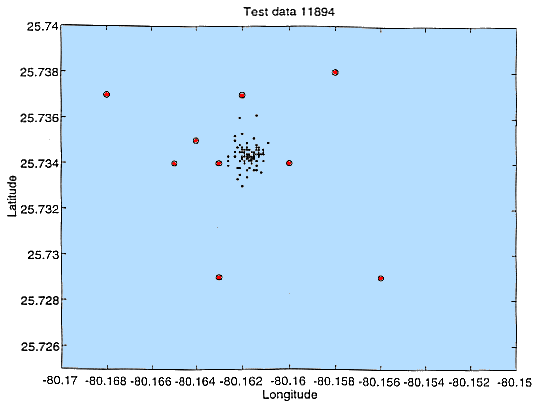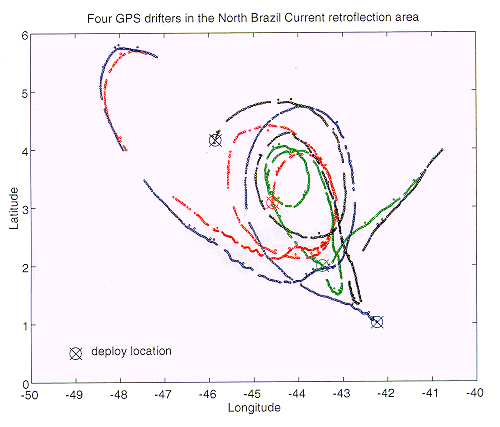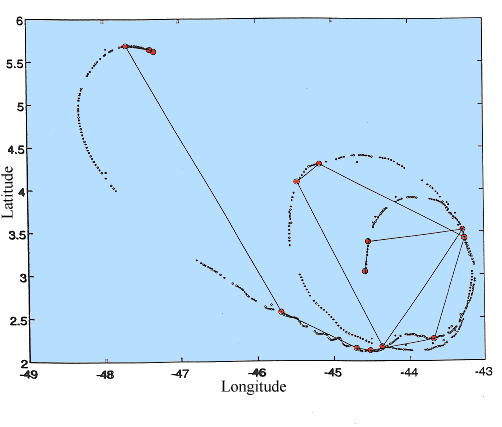
Figure 1. Drifter 11894 test data prior to deployment. The
drifter was on and stationary for seven days. Large red dots
are Argos positions, small black dots are GPS positions.
PRELIMINARY RESULTS FROM GLOBAL LAGRANGIAN DRIFTERS
USING GPS RECEIVERS
Mark Bushnell, NOAA/AOML-Global Drifter Center
Four standard Global Lagrangian Drifters (GLD), constructed as described by Sybrandy et al
(1991), have been manufactured with GPS receivers aboard. The drifters were manufactured by
Clearwater Instrumentation, who selected the Rockwell NavCore MicroTracker LP GPS receiver
with a patch antenna on the inside of the surface float. Since there is no external antenna mount,
the drifters resemble a standard drifter in every way. The drifters logged hourly GPS fixes and
stored them, transmitting 16 hourly positions in four interleaved data "pages". The drifters also
made use of the Argos Limited Use 1/3 duty cycle, transmitting for three hours and off for six
hours.
One of the drifters was tested at AOML prior to deployment. Drifter 11894 was activated on 02
April 1995. It was held stationary and active for a week, and the resulting Argos and GPS
positions are seen in Figure 1. Nineteen satellite passes yielded 10 Argos positions, with
standard deviations of 343 meters in latitude and 350 meters in longitude. During the same time
a total of 115 GPS positions were obtained (from a possible 134 hourly positions). After
discarding 3 outliers, the standard deviations of the GPS positions was 53 meters in latitude and
34 meters in longitude.

The drifters were deployed in the North Brazil Current retroflection region by the merchant
vessel SEA FOX, whose assistance is gratefully acknowledged. By placing them in this
energetic eddy field, it was hoped that the value of the improved positioning technique would be
apparent. They were deployed on July 04, and Figure 2 shows the data from the four drifters for
the month of July. Deployments occurred as the ship crossed latitudes 4N, 3N, 2N, and 1N.
The data shown have not been quality controlled in any way, with the exception of a data
transmission checksum.
Several features of interest are apparent in Figure 2. In addition to the obvious anticyclonic eddy,
it can be seen that the two drifters heading northeast at the end of the month (deployed at 4N
and 2N) both executed a quick anticyclonic turn to exit the eddy. The remaining two drifter
trajectories show small wavelike features, presumed to be tidal interaction with the continental
shelf break at that location. Gaps in the trajectories very nearly coincide in time with each other,
and the cause is unknown.

It is interesting to compare the resulting GPS trajectory to that derived from the Argos positions.
Most standard drifters operate on a one-day-on, two-day-off 1/3 duty cycle rather than the 3
hours on, 6 hours off cycle used for the GPS drifters. To create a data set that would more
closely resemble that of a standard drifter, Argos positions were discarded for two out of every
three days. This subset was then overlaid on the GPS series, and the results are seen in Figure 3.
While the individual positions compare well, it is clear that many of the smaller scale features are
missed by the 1/3 duty Argos positioning.

REFERENCES
Sybrandy, A. L. and P. Niiler, 1991. WOCE/TOGA Lagrangian Drifter Construction Manual. WOCE Report No. 63; SIO Report No. 91/6. Scripps Institution of Oceanography, La Jolla, CA